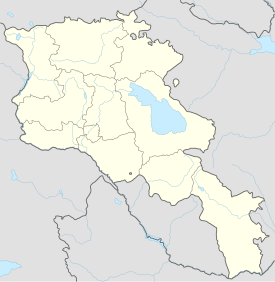Arshakid Mausoleum
| Arshakid Mausoleum Արշակունիների դամբարան |
|
|---|---|

Arshakid Mausoleum (right) and basilica (left)
|
|
| Basic information | |
| Location |
Aghtsk, Aragatsotn Province, |
| Geographic coordinates | 40°18′45″N 44°15′22″E / 40.3125°N 44.2561°ECoordinates: 40°18′45″N 44°15′22″E / 40.3125°N 44.2561°E |
| Affiliation | Armenian Apostolic Church |
| Status | Ruins |
| Architectural description | |
| Architectural type | Mausoleum: Small-cruciform plan; Church: Basilica type plan |
| Architectural style | Armenian |
| Completed | Mausoleum: Mid-late 4th century; Basilica: Late 4th or early 5th century |
The Arshakid Kings Mausoleum and Basilica (Armenian: Արշակունիների դամբարան; also Tomb of the Arshakid Kings or Arshakuni Tomb) is a grave monument complex that sits along a gorge overlooking the Amberd River, and is located in the center of the village of Aghtsk in the Aragatsotn Province of Armenia. It is best known for the mausoleum that once contained the remains of both Christian and pagan kings of the Arshakid dynasty of Armenia. Approximately one hundred meters north of the basilica and tomb complex is a shrine that sits alongside a path leading down to the gorge below, where there are many caves that date from the 16th-18th centuries. Some of the caves have doors and were used during these periods as refuge from invasions.
According to the Epic Histories written by the 5th-century historian Pavstos Buzand (also known as Faustus of Byzantium), he accounts that King Shapur II the Great of Persia after having recaptured Armenia and occupying Ani-Kamakh, discovered there the treasures and tombs of the Armenian Arshakuni Kings. He ordered his troops to exhume the royal remains and in doing so, destroyed the Arshakuni ancestral tombs that were at Ani-Kamakh. There was however the tomb of King Sanatruk that escaped this looting and destruction due to its enormous, impenetrable and ingeniously built structure.
The loot and exhumed remains of the other kings were then carried off en route to Persia with the belief that the land in which the kings' bones were interred would gain their fame, fortune and strength. King Shapur II wanted to reduce the morale of the Armenians as well. The Armenian Sparapet Vassak Mamikonian during the mid-4th century gathered together approximately 60,000 troops and defeated the Persians in the district of Ayrarat, recapturing the treasures and bones of the Armenian kings. He brought the royal remains to Dzorap (modern day Aghtsk) where he soon had them reinterred at a newly constructed mausoleum, separating Christian kings from the pagan kings.
...
Wikipedia

